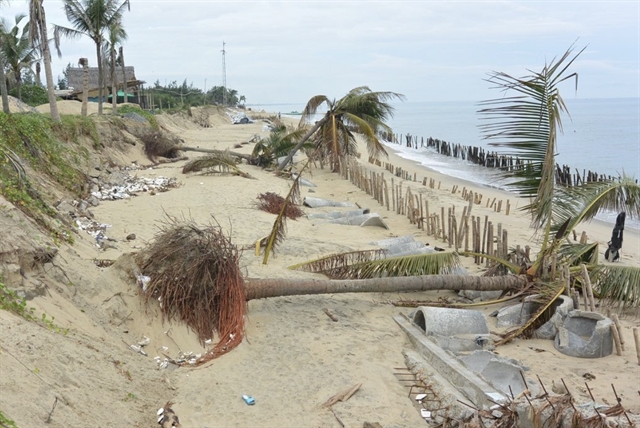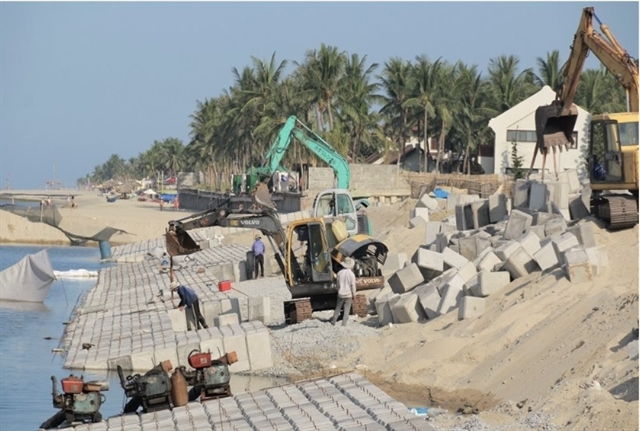 Environment
Environment

 |
| Cửa Đại Beach suffers severe erosion. Photo baotainguyenmoitruong.vn |
QUẢNG NAM – Over the past ten years, Cửa Đại Beach in Hội An Town of Quảng Nam Province has become a place that suffers from the severe impacts of climate change and rising sea levels, with landslides going deeper and deeper into the mainland.
A series of solutions from pumping sand in to nourish the beach and building embankments have been implemented that are expected to completely revive this beautiful coast.
Hội An's coastline is 7km long with many beaches such as Cửa Đại, Thịnh Mỹ and An Bàng. Among them, Cửa Đại is one of the 25 beaches recognised as one of the most beautiful in Asia, but since 2000, it has been suffering from continuous erosion, with the beach disappearing to around 100 metres deep inland and the damage has now extended to Cẩm An Ward.
Now the Âu Cơ Road which runs near the coast is at risk of being affected with hotel and coastal restaurant businesses suffering heavy losses.
So, saving Cửa Đại Beach has become a critical issue for Quảng Nam Province to develop a sustainable plan to protect themselves against the impacts of natural disasters and climate change.
From 2010 to 2015, the province invested in building reinforced concrete embankments with inclined roofs 850m long, soft embankments with geotextile bags over 415 metres of the at risk coastline and geotube fabric bags along a kilometre of the rest, in projects costing more than VNĐ140 billion (US$5.5 million).
But these three projects were not enough and the coast is still being lost.
In June 2020, the province built a 220m underground channel half a metre below sea level, running parallel to the shore along 250m, with an investment of VNĐ40 billion ($1.56 million). The underground dyke has an average height of 4.5 metres, a 12 metre wide base which tapers to one and a half metres at the top. But unfortunately, the project could not be completed due to lack of capital.
Quảng Nam then implemented two projects to build other underground dykes of over 2km and pump 600 cubic metres of sand onto the beach. The two projects cost VNĐ510 billion ($20 million) and helped revive Cửa Đại Beach but north to An Bàng Beach, a stretch of more than a kilometre, continues to be eroded.
The area's urgent issue needs an integrated protection strategy and appropriate and effective coastal management methods.
Lê Thị Yến, a business household on Cửa Đại beach, said that for more than 10 years, when each rainy and stormy season passed, people sadly witnessed the sea encroaching deeper and deeper into the land.
If there were no urgent, even temporary solutions from the local government, perhaps the sea would penetrate even more deeply into the mainland and even swallow the coastal road, Yến said.
"I and many other households thought that there would be no more beaches to reopen for business because the landslides were so terrible,” she said.
“But now the coast is gradually recovering, everyone is happy, hoping tourists will return to this coast."
Sustainable solutions
 |
| Building an embankment to protect Cửa Đại Beach. Photo baotainguyenmoitruong.vn |
The vice chairman of Quảng Nam Provincial People's Committee Hồ Quang Bửu said that recently, the locality had approved the project of anti-erosion and sustainable protection along the coast of Hội An.
The project is funded by the provincial Project Management Board of Agricultural and Rural Development Works and includes three stages of investment in infrastructure construction of soil nourishment and underground dykes; non-structural measures; and project management with a total construction investment of 42 million euros, equivalent to VNĐ982,239 million ($45.3 million).
The investment includes a loan of 35 million euros from the French Development Agency (AFD), two million euros in non-refundable aid from the European Union and five million euros using local funds.
The project is expected to be implemented from mid-2024 to the end of 2026.
The two solutions chosen are to build seven barriers and seven breakwaters along with an environmentally friendly soft solution, delivering sand to the beach to revive local imbalances and improve natural sand transport flow. At the same time, the project will apply an integrated coastal zone management strategy for coastal plains, lowlands, estuaries and sand dunes, monitoring coastline developments along the 80km of coastline from Sơn Trà, Đà Nẵng City to Tam Hải Commune of Quảng Nam Province.
The goal of the project is to build a comprehensive construction solution to prevent erosion and protect Hội An's coastline, meeting the urgent needs of stable housing and economic development of the local community in the project-implemented area including protection of land, houses, property and people's lives, as well as tourism and resort infrastructure for the entire area, over 3.2 square kilometres which house more than 1,300 households in Cửa Đại Ward and surrounding areas.
The project is within the planning and strategic development plan of Hội An Town and is also applicable to tackling and adapting to climate change in coastal areas of Quảng Nam Province.
Nguyễn Thế Hùng, vice chairman of the Hội An People's Committee said that emergency landslide prevention projects were already having a positive impact on efforts to save Cửa Đại beach and Hội An Coastline.
The project to prevent erosion and protect in a sustainable way of Hội An's coastline also offers non-structural solutions and capacity building activities to raise awareness for the project area community in preventing and mitigating natural disasters, reducing the vulnerability of people and natural areas and adjusting customs, according to Hùng.
The project also helps build a legal framework and solutions for integrated coastal management and the Vu Gia - Thu Bồn river system area.
"These are sustainable, long-term solutions," he added. VNS




